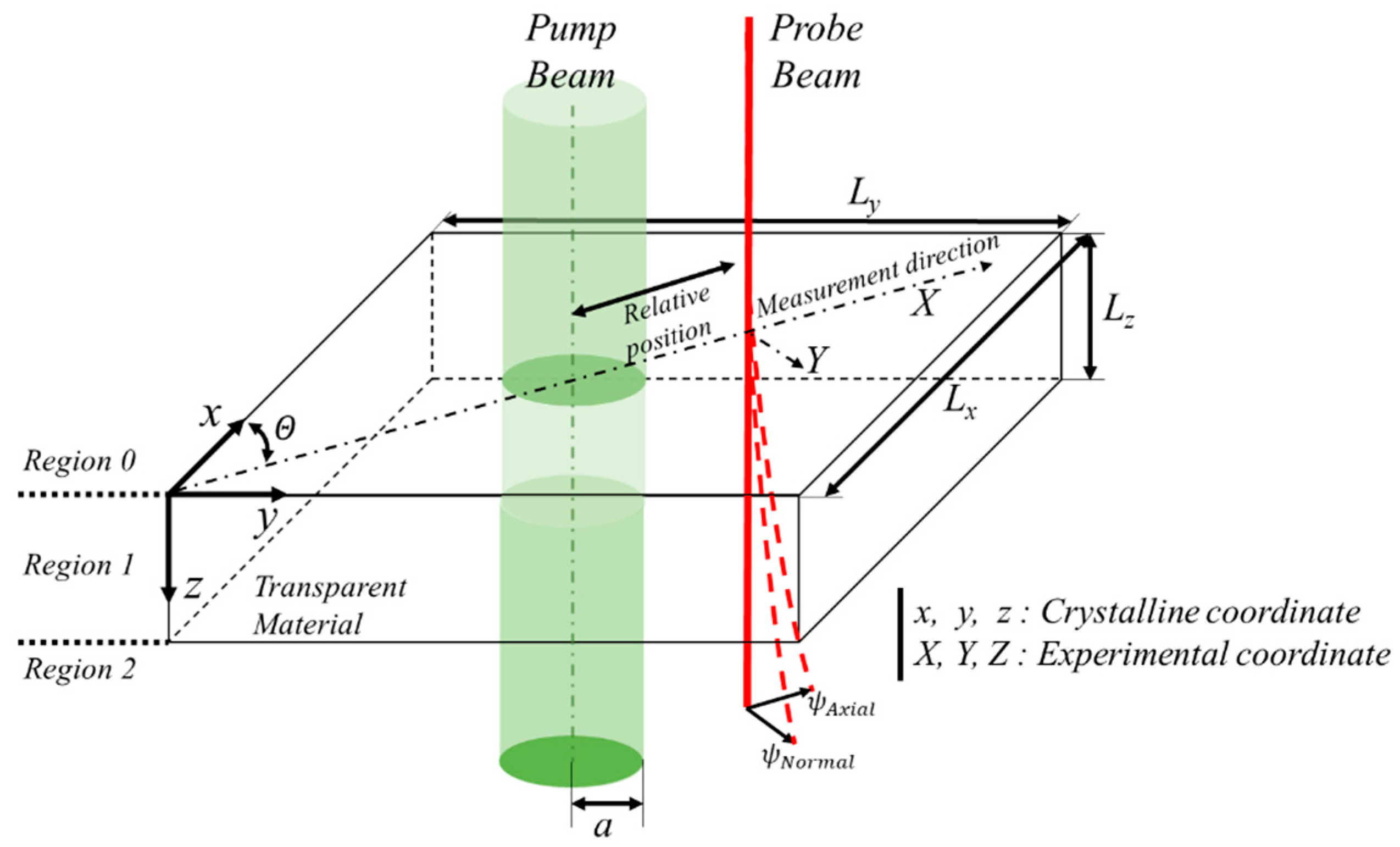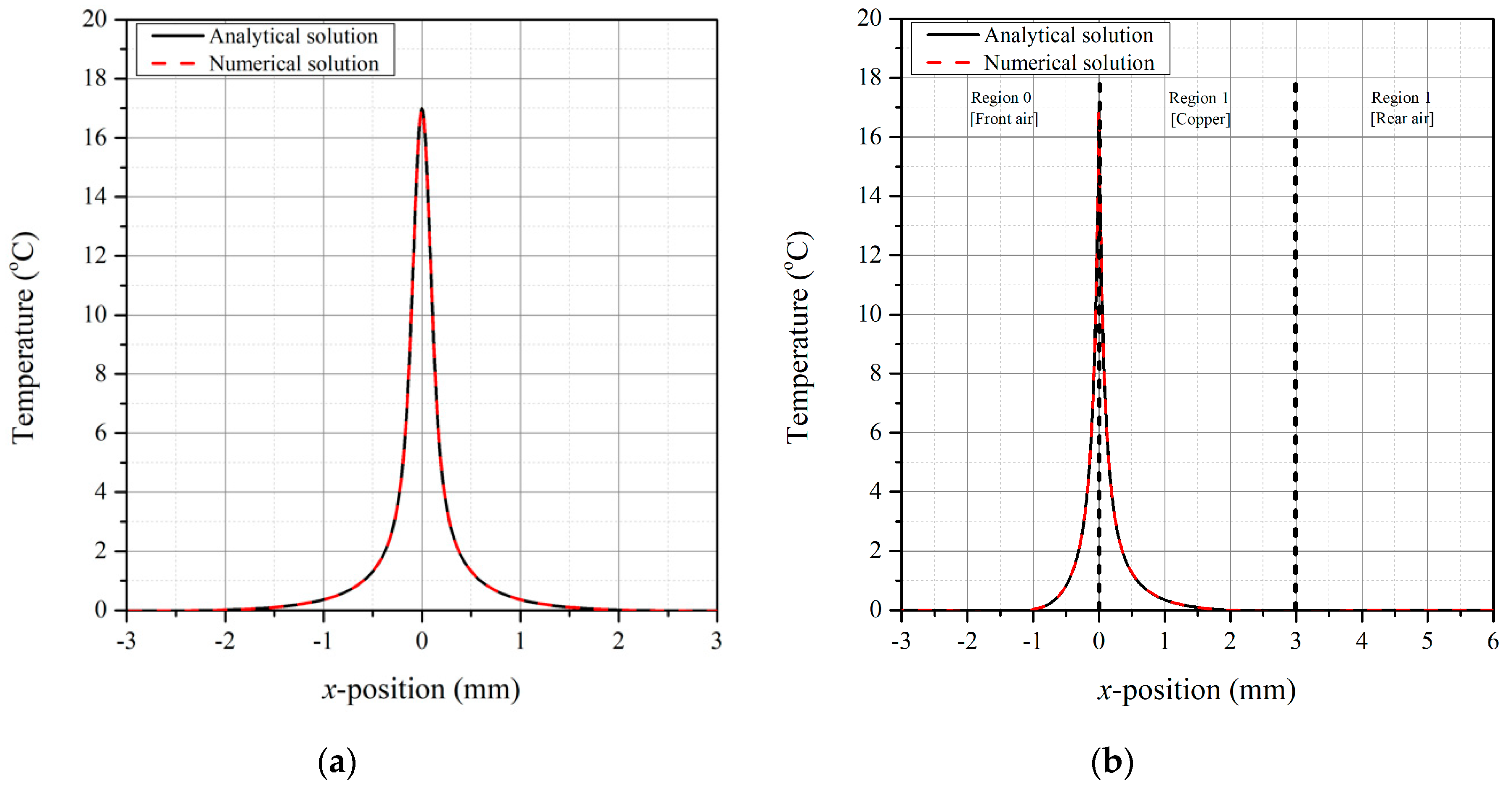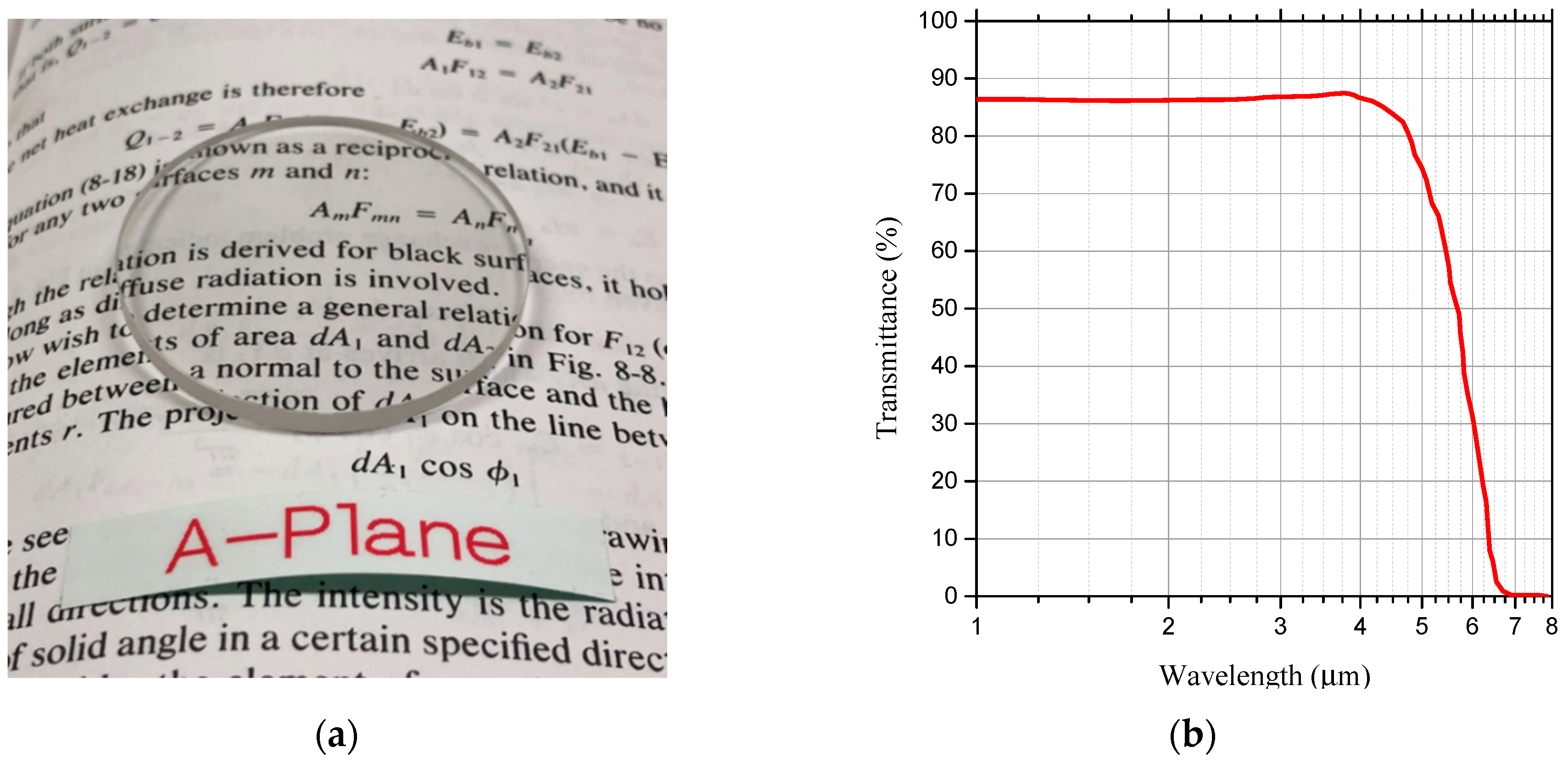Collinear Deflection Method for the Measurement of Thermal Conductivity of Transparent Single Layer Anisotropic Material
Abstract
:1. Introduction
2. Background Theory and Method
2.1. Collinear Deflection Method
2.2. Temperature Distribution Analysis
2.3. Numerical Investigation
2.4. Deflection Analysis
2.5. Algorithm for Determination of Thermal Conductivity
3. Experimental Setup
3.1. Experimental Apparatus
3.2. Specimen for Measurement
3.3. Parameter for Experiment
4. Results and Discussion
5. Conclusions
- Based on the 3D heat conduction equation to which the anisotropic thermal conductivity with the orthorhombic structure was applied, the temperature distribution of the anisotropic material was derived using a complex transformation method and numerical analysis, and it was verified through a comparison with the analytical solution of the well-known mirage deflection method. Deflection analysis was conducted to measure the thermal conductivity of the transparent anisotropic material by applying the derived temperature distribution.
- The measurement method proposed in this study was verified by measuring the effective thermal conductivity according to the principal thermal conductivity directions (, ) and measurement directions using A-plane sapphire glass whose , , and were known to be 36.4, 27.1, and 36.4 W/(mk) from the various literatures.
- The phase curve method algorithm was applied to derive the thermal conductivity of the measurement specimen using the phase curve results according to the relative position (distance between the pump beam and the probe beam) derived from the experiment. The RMSE ranged from 2.97 to 5.25° depending on the measurement direction.
- It was confirmed that the measured thermal conductivity according to the finally derived direction () had absolute errors less than about 4 W/(mk) when compared with the average of literature values.
Author Contributions
Funding
Conflicts of Interest
References
- Oktay, S.; Hannemann, R.; Bar-Cohen, A. High heat from a small package. Mech. Eng. (USA) 1986, 108, 36–42. [Google Scholar]
- Nakayama, W. Thermal management of electronic equipment: A review of technology and research topics. Appl. Mech. Rev. 1986, 39, 1847–1868. [Google Scholar] [CrossRef]
- Incropera, F. Convection heat transfer in electronic equipment cooling. J. Heat Transf. 1988, 110, 1097–1111. [Google Scholar] [CrossRef]
- Bar-Cohen, A. Thermal management of electronic components with dielectric liquids. JSME Int. J. Ser. B Fluids Therm. Eng. 1993, 36, 1–25. [Google Scholar] [CrossRef]
- Kubo, W.; Fujikawa, S. Embedding of a gold nanofin array in a polymer film to create transparent, flexible and anisotropic electrodes. J. Mater. Chem. 2009, 19, 2154–2158. [Google Scholar] [CrossRef]
- Bae, S.; Kim, H.; Lee, Y.; Xu, X.; Park, J.-S.; Zheng, Y.; Balakrishnan, J.; Lei, T.; Kim, H.R.; Song, Y.I. Roll-to-roll production of 30-inch graphene films for transparent electrodes. Nat. Nanotechnol. 2010, 5, 574–578. [Google Scholar] [CrossRef] [Green Version]
- Mietta, J.L.; Ruiz, M.M.; Antonel, P.S.; Perez, O.E.; Butera, A.; Jorge, G.; Negri, R.M. Anisotropic magnetoresistance and piezoresistivity in structured Fe3O4-silver particles in PDMS elastomers at room temperature. Langmuir 2012, 28, 6985–6996. [Google Scholar] [CrossRef]
- Uetani, K.; Okada, T.; Oyama, H.T. Thermally conductive and optically transparent flexible films with surface-exposed nanocellulose skeletons. J. Mater. Chem. C 2016, 4, 9697–9703. [Google Scholar] [CrossRef]
- Powell, R.; Taylor, R. Multi-Property Apparatus and Procedure for High Temperature Determinations; Purdue Univ., Lafayette, Ind.: West Lafayette, IN, USA, 1970. [Google Scholar]
- Taylor, R.; Kimbrough, W.; Powell, R. Thermophysical properties of tantalum, tungsten, and tantalum-10 wt. per cent tungsten at high temperatures. J. Less Common Met. 1971, 24, 369–382. [Google Scholar] [CrossRef]
- Taylor, R. Determination of thermophysical properties by direct electric heating. High Temp. High Press. 1981, 13, 9–22. [Google Scholar]
- Cezairliyan, A.; Morse, M.; Beckett, C. Measurement of melting point and electrical resistivity (above 2840 deg K) of molybdenum by a pulse heating method. Rev. Int. Des Ht. Temp. Et Des Refract. 1970, 7, 382–388. [Google Scholar]
- Cezairliyan, A. Design and operational characteristics of a high-speed (millisecond) system for the measurement of thermophysical properties at high temperatures. J. Res. Nat. Bur. Stand.(US) C 1971, 75, 7–18. [Google Scholar] [CrossRef]
- Cezairliyan, A.; Miiller, A. Specific heat capacity and electrical resistivity of a carbon-carbon composite in the range 1500–3000 k by a pulse heating method. Int. J. Thermophys. 1980, 1, 317–326. [Google Scholar] [CrossRef]
- Sell, J. Photothermal Investigations of Solids and Fluids; Academic Press INC.: Boston, MA, USA, 1989. [Google Scholar]
- Cahill, D.G.; Katiyar, M.; Abelson, J. Thermal conductivity of a-Si: H thin films. Phys. Rev. B 1994, 50, 6077. [Google Scholar] [CrossRef]
- Vozár, L.; Hohenauer, W. Flash method of measuring the thermal diffusivity. A review. High Temp.-High Press. 2004, 36, 253–264. [Google Scholar] [CrossRef]
- Jackson, W.B.; Amer, N.M.; Boccara, A.; Fournier, D. Photothermal deflection spectroscopy and detection. Appl. Opt. 1981, 20, 1333–1344. [Google Scholar] [CrossRef] [PubMed]
- Fournier, D.; Boccara, C.; Skumanich, A.; Amer, N.M. Photothermal investigation of transport in semiconductors: Theory and experiment. J. Appl. Phys. 1986, 59, 787–795. [Google Scholar] [CrossRef]
- Spear, J.D.; Russo, R.E.; Silva, R.J. Collinear photothermal deflection spectroscopy with light-scattering samples. Appl. Opt. 1990, 29, 4225–4234. [Google Scholar] [CrossRef] [PubMed]
- Salazar, A.; Sánchez-Lavega, A.; Fernandez, J. Thermal diffusivity measurements in solids by the ‘‘mirage’’technique: Experimental results. J. Appl. Phys. 1991, 69, 1216–1223. [Google Scholar] [CrossRef]
- Bertolotti, M.; Liakhou, G.; Li Voti, R.; Peng Wang, R.; Sibilia, C.; Yakovlev, V. Mirror temperature of a semiconductor diode laser studied with a photothermal deflection method. J. Appl. Phys. 1993, 74, 7054–7060. [Google Scholar] [CrossRef]
- Rantala, J.; Wei, L.; Kuo, P.; Jaarinen, J.; Luukkala, M.; Thomas, R. Determination of thermal diffusivity of low-diffusivity materials using the mirage method with multiparameter fitting. J. Appl. Phys. 1993, 73, 2714–2723. [Google Scholar] [CrossRef]
- Spear, J.D.; Silva, R.J.; Klunder, G.L.; Russo, R.E. Collinear photothermal deflection spectroscopy of liquid samples at varying temperature. Appl. Spectrosc. 1993, 47, 1580–1584. [Google Scholar] [CrossRef]
- Salazar, A.; Sánchez-Lavega, A.; Fernández, J. Thermal diffusivity measurements on solids using collinear mirage detection. J. Appl. Phys. 1993, 74, 1539–1547. [Google Scholar] [CrossRef]
- Bertolotti, M.; Liakhou, G.; Ferrari, A.; Ralchenko, V.; Smolin, A.; Obraztsova, E.; Korotoushenko, K.; Pimenov, S.; Konov, V. Measurements of thermal conductivity of diamond films by photothermal deflection technique. J. Appl. Phys. 1994, 75, 7795–7798. [Google Scholar] [CrossRef]
- Salazar, A.; Sánchez-Lavega, A. Low temperature thermal diffusivity measurements of gases by the mirage technique. Rev. Sci. Instrum. 1999, 70, 98–103. [Google Scholar] [CrossRef]
- Li, B.; Gupta, R. Simultaneous measurement of absorption coefficient, thermal diffusivity, and flow velocity in a gas jet with pulsed photothermal deflection spectroscopy. J. Appl. Phys. 2001, 89, 859–868. [Google Scholar] [CrossRef]
- Jeon, P.; Lee, E.; Lee, K.; Yoo, J. A theoretical study for the thermal diffusivity measurement using photothermal deflection scheme. Energy Eng. J. 2001, 10, 63–70. [Google Scholar]
- Salazar, A.; Gateshki, M.; Gutiérez-Juárez, G.; Sánchez-Lavega, A.; Ang, W.T. Novel results on collinear mirage deflection. Anal. Sci. 2001, 17, 95–98. [Google Scholar]
- Iravani, M.V.; Nikoonahad, M. Photothermal waves in anisotropic media. J. Appl. Phys. 1987, 62, 4065–4071. [Google Scholar] [CrossRef]
- Quelin, X.; Perrin, B.; Louis, G.; Peretti, P. Three-dimensional thermal-conductivity-tensor measurement of a polymer crystal by photothermal probe-beam deflection. Phys. Rev. B 1993, 48, 3677. [Google Scholar] [CrossRef]
- Salazar, A.; Sánchez-Lavega, A.; Ocáriz, A.; Guitonny, J.; Pandey, J.; Fournier, D.; Boccara, A. Novel results on thermal diffusivity measurements on anisotropic materials using photothermal methods. Appl. Phys. Lett. 1995, 67, 626–628. [Google Scholar] [CrossRef]
- Salazar, A.; Sánchez-Lavega, A.; Ocariz, A.; Guitonny, J.; Pandey, G.; Fournier, D.; Boccara, A. Thermal diffusivity of anisotropic materials by photothermal methods. J. Appl. Phys. 1996, 79, 3984–3993. [Google Scholar] [CrossRef]
- Murphy, J.C.; Spicer, J.M.; Aamodt, L.C.; Royce, B.S. Photoacoustic and photothermal phenomena II. Baltimore, Maryland, July 31–August 3, 1989. Available online: https://link.springer.com/book/10.1007/978-3-540-46972-8 (accessed on 10 April 2019).
- Lee, K.; Kang, J.; Jeon, P.; Jo, B.; Yoo, J.; Kim, H. Measurement of thermal conductivity for single-and bilayer materials by using the photothermal deflection method. J. Korean Phys. Soc. 2007, 51, 36. [Google Scholar] [CrossRef]
- Jeon, P.; Kim, J.; Kim, H.; Yoo, J. Thermal conductivity measurement of anisotropic material using photothermal deflection method. Thermochim. Acta 2008, 477, 32–37. [Google Scholar] [CrossRef]
- Ross, R.B. Metallic Materials Specification Handbook; Springer Science & Business Media: Berlin, Germany, 2013. [Google Scholar]
- Carslaw, H.S.; Jaeger, J.C. Conduction of Heat in Solids; Clarendon Press: Oxford, UK, 1960. [Google Scholar]
- McKie, C.; McKie, D. Newnham. Structure-Property Relations (Crystal Chemistry of Non-Metallic Materials, Vol. 2). Mineral. Mag. 1977, 41, 143–144. [Google Scholar] [CrossRef]
- Putnis, A. An Introduction to Mineral Sciences; Cambridge University Press: Cambridge, UK, 1992. [Google Scholar]
- Lovett, D. Tensor Properties of Crystals; CRC Press: Boca Raton, FL, USA, 2018. [Google Scholar]
- Dobrovinskaya, E.R.; Lytvynov, L.A.; Pishchik, V. Sapphire: Material, Manufacturing, Applications; Springer Science & Business Media: Berlin, Germany, 2009. [Google Scholar]
- Ho, C.Y.; Powell, R.W.; Liley, P.E. Thermal Conductivity of the Elements: A Comprehensive Review. J. Phys. Chem. Ref. Data 1974, 3, 1–30. [Google Scholar]
- Kinoshita, H.; Otani, S.; Kamiyama, S.; Amano, H.; Akasaki, I.; Suda, J.; Matsunami, H. Zirconium diboride (0001) as an electrically conductive lattice-matched substrate for gallium nitride. Jpn. J. Appl. Phys. 2001, 40, L1280. [Google Scholar] [CrossRef]
- Knapp, W. Thermal conductivity of nonmetallic single crystals. J. Am. Ceram. Soc. 1943, 26, 48–55. [Google Scholar] [CrossRef]
- Darwish, A.M.; Bayba, A.J.; Hung, H.A. Thermal resistance calculation of AlGaN-GaN devices. IEEE Trans. Microw. Theory Tech. 2004, 52, 2611–2620. [Google Scholar] [CrossRef]
- Schmid, F.; Rogers, H.H.; Khattak, C.P.; Felt, D.M. Growth of very large sapphire crystals for optical applications. Inorg. Opt. Mater. 1998, 3424, 3–47. [Google Scholar]
- Hagemann, H.-J.; Gudat, W.; Kunz, C. Optical constants from the far infrared to the x-ray region: Mg, Al, Cu, Ag, Au, Bi, C, and Al2O3. JOSA 1975, 65, 742–744. [Google Scholar] [CrossRef]












| Method | Limitation | |
|---|---|---|
| Contact | DC heating [9,10,11] | Conductive materials only |
| Pulse heating [12,13,14] | Conductive materials only | |
| Laser calorimetry [15] | Large amount of heat loss | |
| 3ω method | Complexity damage of specimen | |
| Non-Contact | Photo Acoustic [15] | Low accuracy |
| Laser Flash [17] | Damage of specimen & Limitation of shape/size | |
| Photothermal radiometry [15] | Problem of emissivity factor | |
| Photothermal reflection [15] | Standardization of roughness on surface of specimen | |
| Photothermal displacement [15] | Surface treatment of specimen | |
| Photothermal deflection [15] | Increase of S/N |
| Length (mm) | ||
|---|---|---|
| 20 | ||
| 20 | ||
| Region 0 | 6 | |
| Region 1 | 3 | |
| Region 2 | 6 | |
| Copper [38] | Air [3] | |
|---|---|---|
| Density | 8930 | 1.1614 |
| Specific heat capacity | 385 | 1007 |
| Thermal conductivity | 398 | 0.0263 |
| Absorption coefficient | 7.01 × 107 | - |
| Thermo-optical coefficient | 2.22 | 2.55 × 10−5 |
| Pump beam radius | 100 | |
| Number of Nodes | Computing Time | Temperature (°C) | |||
|---|---|---|---|---|---|
| X-Position | |||||
| 0 mm | 0.15 mm | 0.3 mm | 0.45 mm | ||
| 26,901 | 10s | 2.5412 | 2.3569 | 1.3154 | 0.8852 |
| 87,451 | 22s | 2.6542 | 2.1516 | 1.2987 | 0.8751 |
| 203,401 | 49s | 2.7567 | 2.1159 | 1.2256 | 0.9045 |
| 348,145 | 105s | 2.8457 | 2.2548 | 1.4146 | 0.8912 |
| 549,081 | 120s | 2.7542 | 2.1987 | 1.3554 | 0.8759 |
| 815,425 | 223s | 3.0157 | 2.2247 | 1.4254 | 0.8945 |
| 976,005 | 253s | 3.2187 | 2.4194 | 1.4610 | 0.9153 |
| 1,156,393 | 379s | 3.2235 | 2.4243 | 1.4646 | 0.9192 |
| 1,357,741 | 3,868s | 3.2234 | 2.4245 | 1.4648 | 0.9190 |
| Measurement Temperature | Literature Author | Average Value | ||
|---|---|---|---|---|
| x-dir () and z-dir () | 32.5 | 298 | Dobrovinskaya et al [43] | 36.4 ( 8.5) |
| 25.2 | 300 | Ho et al [44] | ||
| 47 | 298 | Kinoshita et al [45] | ||
| 42.3 | 303 | Knapp [46] | ||
| 35 | 300 | Darwish et al [47] | ||
| y-dir ( | 30.3 | 298 | Dobrovinskaya et al [43] | 27.1 (± 4.1) |
| 23.1 | 300 | Ho et al [44] | ||
| 31 | 298 | Kinoshita et al [45] | ||
| 24 | 300 | Schmid et al [48] | ||
| 3980 | ||
| Specific heat capacity | 761 | |
| Thermal conductivity | x-dir () | 32.5 |
| y-dir ( | 23.1 | |
| z-dir () | 32.5 | |
| Absorption coefficient | 653.05 | |
| Thermo-optical coefficient | 1.30 × 10−5 | |
| Frequency (Hz) | 20 |
| Radius (mm) | 82.5 |
| Relative position (Numerical) (mm) | 0.15~0.5 (interval: 0.02) |
| Relative position (Experimental) (mm) | 0.15~0.5 (interval: 0.02) |
| Measurement angle(deg) | 0 | 30 | 45 | 60 | 90 |
| Literature value | 36.40 (8.5) | 34.10 (± 7.4) | 31.75 (± 6.3) | 29.43 (± 5.2) | 27.10 (± 4.1) |
| Measurement value | 32.23 | 29.97 | 28.17 | 25.58 | 23.54 |
| Root mean square error(deg) | 3.3 | 5.52 | 3.18 | 4.47 | 2.97 |
| Absolute error | 4.17 | 4.13 | 3.58 | 3.85 | 3.56 |
© 2019 by the authors. Licensee MDPI, Basel, Switzerland. This article is an open access article distributed under the terms and conditions of the Creative Commons Attribution (CC BY) license (http://creativecommons.org/licenses/by/4.0/).
Share and Cite
Kim, M.; Park, K.; Kim, G.; Yoo, J.; Kim, D.-K.; Kim, H. Collinear Deflection Method for the Measurement of Thermal Conductivity of Transparent Single Layer Anisotropic Material. Appl. Sci. 2019, 9, 1522. https://doi.org/10.3390/app9081522
Kim M, Park K, Kim G, Yoo J, Kim D-K, Kim H. Collinear Deflection Method for the Measurement of Thermal Conductivity of Transparent Single Layer Anisotropic Material. Applied Sciences. 2019; 9(8):1522. https://doi.org/10.3390/app9081522
Chicago/Turabian StyleKim, Moojoong, Kuentae Park, Gwantaek Kim, Jaisuk Yoo, Dong-Kwon Kim, and Hyunjung Kim. 2019. "Collinear Deflection Method for the Measurement of Thermal Conductivity of Transparent Single Layer Anisotropic Material" Applied Sciences 9, no. 8: 1522. https://doi.org/10.3390/app9081522




